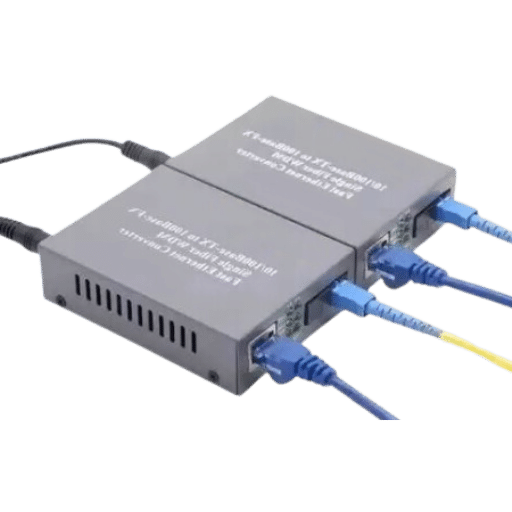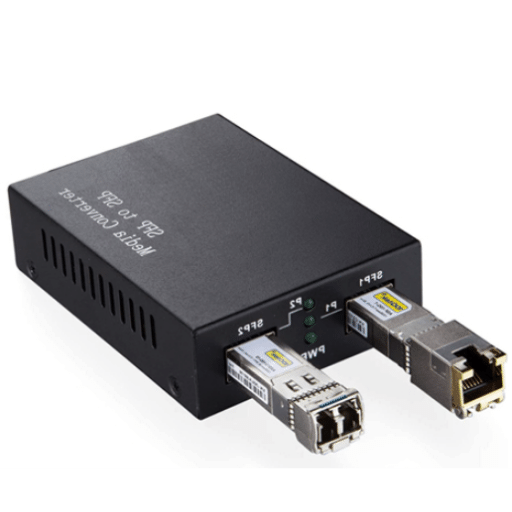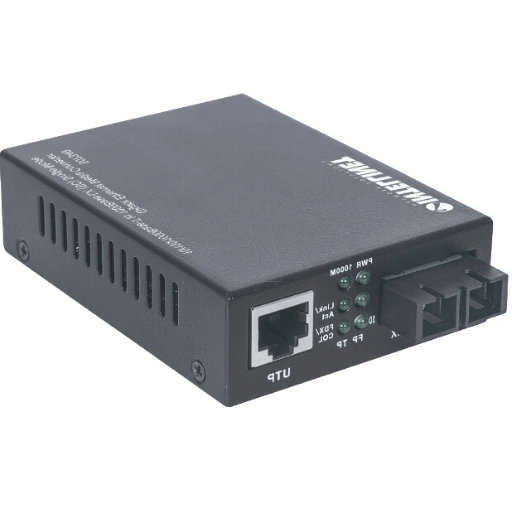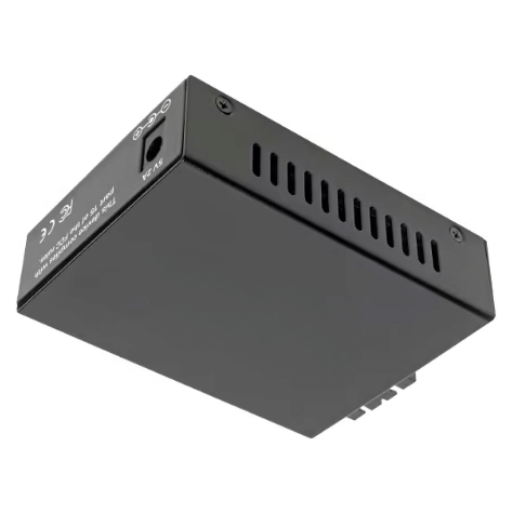A media converter is a networking device that converts the signals transmitted between two media types: fiber optic cable and copper wire. It facilitates the seamless data transmission between devices that use different types of cabling or media.

Data transmission often involves the use of different types of cabling. While copper wire is ideal for short distances, fiber optic cables are preferred for long-distance communications. Media conversion, therefore, becomes necessary when two devices that use different types of cabling need to communicate with each other.
Recommended Reading: Single Mode vs. Multimode Fiber
Fiber media converters are a type of media converter that converts the electrical signals transmitted over copper wire into optically encoded signals sent via fiber optic cables. These converters enable devices that use copper wiring to communicate with devices that use fiber optic cables.
There are various types of media converters in the market. Standard media converters are designed for copper-to-fiber connections, while universal media converters allow for relationships between different fiber types. Mini-media converters are portable and compact, while managed media converters offer advanced remote monitoring and management features.
Media converters offer several benefits, such as facilitating data transfer over longer distances, improving data integrity ,reducing signal interference, and integrating legacy equipment with newer technology. They can also add new devices to the network as and when required.
To choose the correct media converter, you must consider factors such as the distance of the data transmission, the cabling you are already using, and the cabling the device needs. You should also consider the bandwidth capacity required and the environment in which the media converter will operate.
A Media Converter operates by converting one network media signal to another. This means it can convert signals transmitted through copper cabling to fiber-optic cabling and vice versa. It allows two dissimilar media types to connect and communicate with each other.
Media Converters use certain technological principles and functionalities to convert signals. First, media converters decode the signal into its base components, translate these components into a suitable format to be transmitted, then re-encode the movement in the new design before transmission. Moreover, media converters are vital in ensuring seamless communication between two devices.
Gigabit and Fast Ethernet are two Ethernet network standards that play a crucial role in media conversion. Gigabit Ethernet provides high-speed connectivity, while Fast Ethernet transmits data at 100 Mbps. Both technologies are used to upgrade a network’s capacity. In media conversion, the bandwidth and speed of the network directly impact the media conversion process.
There are various types of Media Converters available in the market. Some standard media converters include copper-to-fiber converters, fiber-to-fiber converters, and media converters with PoE (Power over Ethernet) capability. Copper-to-fiber converters are perfect for transmitting data over long distances; fiber-to-fiber provides connectivity between multiple fiber types. Media Converters with PoE are beneficial in power-dependent locations.
Wavelength is an essential component in media conversion. The wavelength measures the distance between two points in a wave, known as a frequency. In media conversion, the wavelength determines the transmission distance and speed. When converting a media signal from copper to fiber, the wavelength must be aligned correctly to ensure seamless communication.
Managed Media Converters allow network managers to configure the devices remotely, while unmanaged media converters are plug-and-play devices with no customization options. Controlled media converters are more suitable for complex networks, allowing administrators to conduct real-time monitoring and configure settings according to network requirements. On the other hand, unmanaged media converters are typically less expensive and easier to use, making them ideal for smaller, less complex networks.
Media converters are devices that allow different types of network media to communicate with each other. This enables network administrators to integrate and extend their network infrastructure without replacing hardware.
Recommended Reading: SFP+ Module: Everything You Need to Know
Media converters come in different types, including copper-to-fiber, fiber-to-copper, and fiber-to-fiber. Copper-to-fiber media converters convert copper Ethernet signals to fiber optic signals, whereas fiber-to-copper media converters convert fiber optic signals to copper Ethernet signals. Fiber-to-fiber media converters, on the other hand, convert fiber optic signals to different wavelengths or connector types. Network administrators can use fiber-to-fiber media converters to integrate different fiber optic types and wavelengths, making extending their network’s reach easier.
Fiber-to-fiber media converters offer advantages, including increased flexibility, scalability, and enhanced network performance. With fiber-to-fiber media converters, network administrators can connect different fiber types and wavelengths, so they don’t have to replace existing hardware when they want to extend their network. They can also quickly scale their network by adding new fiber connections. In addition, fiber-to-fiber media converters offer better network performance by reducing latency and minimizing signal degradation.
Small Form-Factor Pluggable (SFP) transceivers are modular optical transceivers that can be easily interchanged between fiber optic media converters. SFP transceivers provide maximum flexibility, as they can be replaced or updated as needed. They also offer the advantage of transmitting data over long distances and at high speeds, making them ideal for media conversion.
Multimode and single-mode media converters are used based on the transmission distance required. Multimode media converters are typically used for short distances, up to 550 meters, and use a larger optical fiber core diameter. Single-mode media converters are used for longer distances, up to 10km, and use a smaller optical fiber core diameter. Single-mode media converters offer higher bandwidth and longer transmission distances, while multimode media converters are less expensive and easier to install.
Media converters typically have multiple ports, including a fiber optic port, a copper Ethernet port, and sometimes a console port. The fiber optic port connects the media converter to the fiber optic network. The copper Ethernet port connects the media converter to the copper Ethernet network. The console port is used for configuration and management.

Media converters come in two main form factors: standalone and chassis-based. Standalone media converters are compact, portable, and easily deployed in small network segments. On the other hand, chassis-based media converters are designed for high-density installations, offering a solution when multiple media converters are required. Standalone media converters are less expensive and easier to install, while chassis-based media converters offer higher port density and better scalability.
Media converters are essential to modern network infrastructure, especially with diverse media types. They play a critical role in efficiently bridging various network media types and enabling seamless communication across distributed networks. This comprehensive guide will delve into the importance of media converters, their essential functions, and the different scenarios in which they offer numerous benefits.
Media converters help to interconnect different network media types, including copper cabling, fiber optics, wireless, and coaxial cables. They perform this crucial function by converting signals between network media types to ensure seamless connectivity. By doing so, media converters enable devices that use different media types to communicate and work together successfully.
Media converters allow for different network media types in a single network, which helps reduce network infrastructure costs and complexity. For example, a media converter can connect copper-based devices to a fiber-based network, facilitating data communication between them. This functionality makes media converters a cost-effective way to upgrade network infrastructure without entirely replacing it.
Media converters play an essential role in enhancing the connectivity of fiber networks. Fiber networks have several advantages over copper-based networks, including higher bandwidth capacities and longer transmission distances. However, fiber-optic cables have several limitations, making connecting them directly to devices such as computers and routers challenging.
Media converters provide a solution to this problem, as they can convert optical signals to electrical signals and vice versa. This functionality makes connecting fiber-optic networks to copper-based devices possible, making the transition to fiber-based networks more accessible.
Media converters can also be used for multiplexing, which involves combining multiple signals into one signal. This process enables data transmission across a single cable or media. This feature is handy when dealing with bandwidth-intensive applications like video streaming.
Media converters that support multiplexing can combine several signals into a single call, which can then be transmitted through a single cable. This results in more efficient use of network resources by reducing the need for additional wires and media.
Media converters can also extend the reach of gigabit Ethernet, which has a data transfer rate of up to 1000 Mbps. This functionality means that media converters can assist networks in expanding their space up to 100 kilometers by converting electrical standards into compatible signals.
Media converters can be used in various scenarios to boost network performance. For instance, they can be used to extend the range of a network by extending the physical distance that connections can cover. Additionally, media converters can connect specific devices, such as IP cameras, providing a robust network foundation to support the devices.
Media converters can also improve network connectivity by overcoming the bandwidth limitations of specific systems or devices. In cases where copper-based cables are too short or have reached the end of their lifecycle, media converters can convert signals to fiber optics to facilitate communication.
Choosing a suitable media converter is crucial for anyone with fiber optic cabling. A media converter is a device that allows communication between different network types by converting signals from one medium to another. It is an essential link between various networks to maintain contact between devices.

Recommended Reading: What is OEO in WDM system
Budget: This is a crucial factor when choosing a media converter. You need to consider the cost of the converter and whether it fits your budget. You can compare the prices of different media converters to find the most affordable and reliable option.
Transmission distance: Transmission distance is another vital factor to consider. You need to choose a media converter that can transmit signals over the required distance safely and securely without any signal loss.
Network Types: The media converter’s compatibility with your network type is critical. You must ensure the media converter can support your network type, whether EEthernet fiber or copper.
Media Type: You need to consider the media type you are using. Depending on your needs, a media converter can convert fiber to copper, fiber to thread, or copper to the line.
When selecting a media converter, you must choose between single-mode and multimode media converters. Single-mode media converters are preferred for long-distance transmissions, usually above 10 kilometers. Multimode converters are ideal for shorter distances and LAN networking within a building.
Chassis-based media converters provide modular networking solutions. They allow a flexible configuration of media converters that suit your needs. They are customizable, modular, and scalable for future upgrades. However, they are more expensive than standalone converters.
You need to evaluate your particular needs to find a suitable media converter. First, you must identify the network type and transmission distance. You also need to determine the right fiber cable type. You can then compare different media converters with the necessary features to find the right one for your needs.
Recommended Reading: 10G DAC High-Speed Cable VS 10G AOC Active Optical Cable: Who is better?

A: There are several types of media converters available, including gigabit media converters, fast ethernet media converters, and ethernet media converters. These converters come in both single-mode and multimode options.
A: Single-mode media converters are designed with single-mode fiber optic cabling, allowing for longer distances and higher bandwidth. Multimode media converters, on the other hand, are used with multimode fiber optic cabling, which is typically used for shorter distances.
A: A managed media converter allows for better control and monitoring of the converter, usually through a web-based interface or SNMP (Simple Network Management Protocol). This allows for easier troubleshooting and configuration.
A: Fiber-to-fiber media converters convert one type of fiber optic connector or wavelength to another. This is useful when connecting different fiber optic cables or converting from one wavelength to another.
A: SFP (Small Form-factor Pluggable) transceivers are modular devices easily inserted into media converters to provide different interfaces, such as copper or fiber connections. They are used to adapt the media converter to the network’s specific needs.
A: Fiber media converters offer several advantages, including higher bandwidth capabilities, longer distance transmission, immunity to electromagnetic interference (EMI), and the ability to transmit data securely over long distances without loss of signal quality.
A: Media converters can be used in single-mode and multimode environments. They are designed to be compatible with both types of fiber optic cabling.
A: A standalone media converter is a compact and independent device easily connected to other network devices. It does not require a separate chassis or rack for installation.
A: A chassis-based media converter is a modular device that can be installed in a rack or chassis. It allows for easy expansion and scalability, as multiple media converters can be installed in the same chassis.